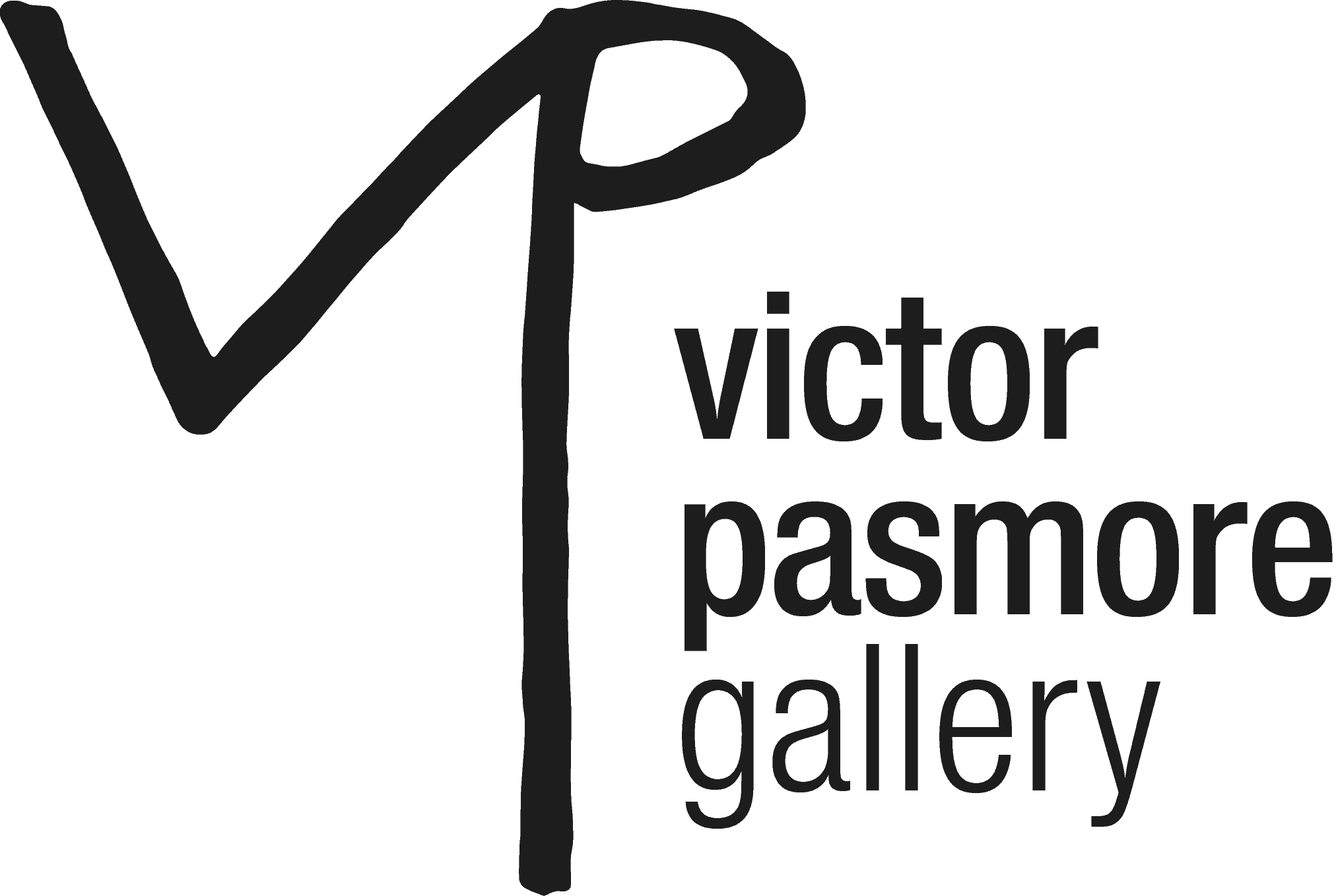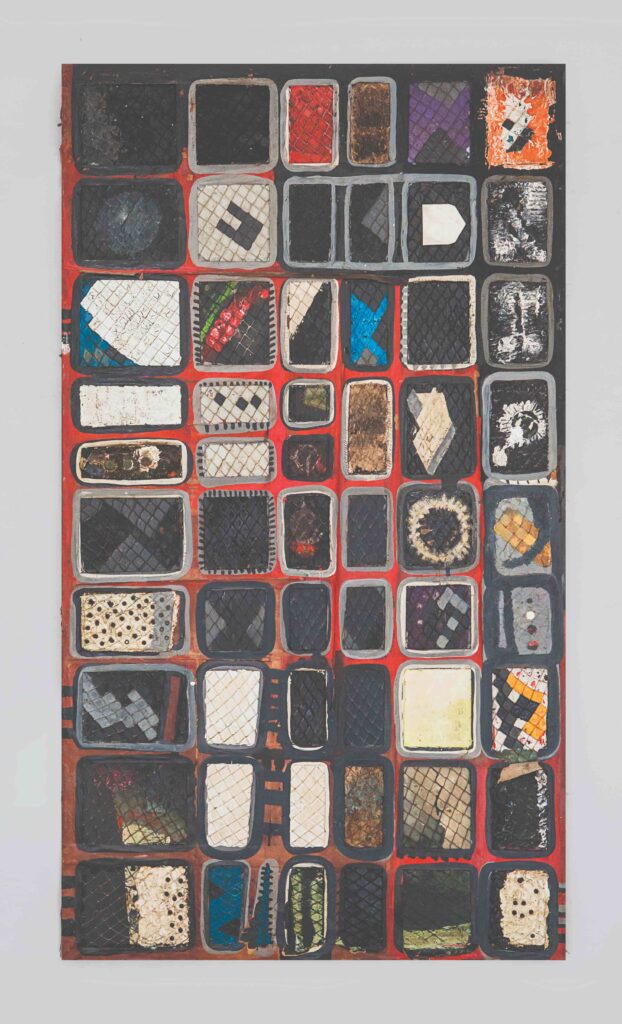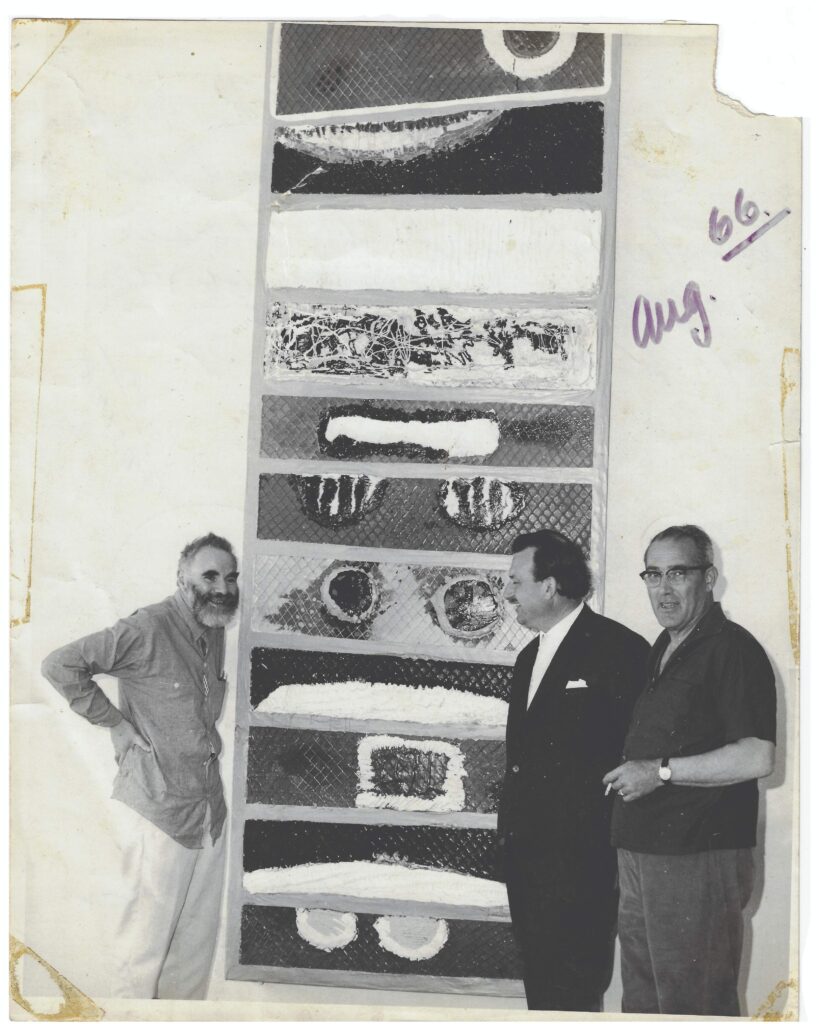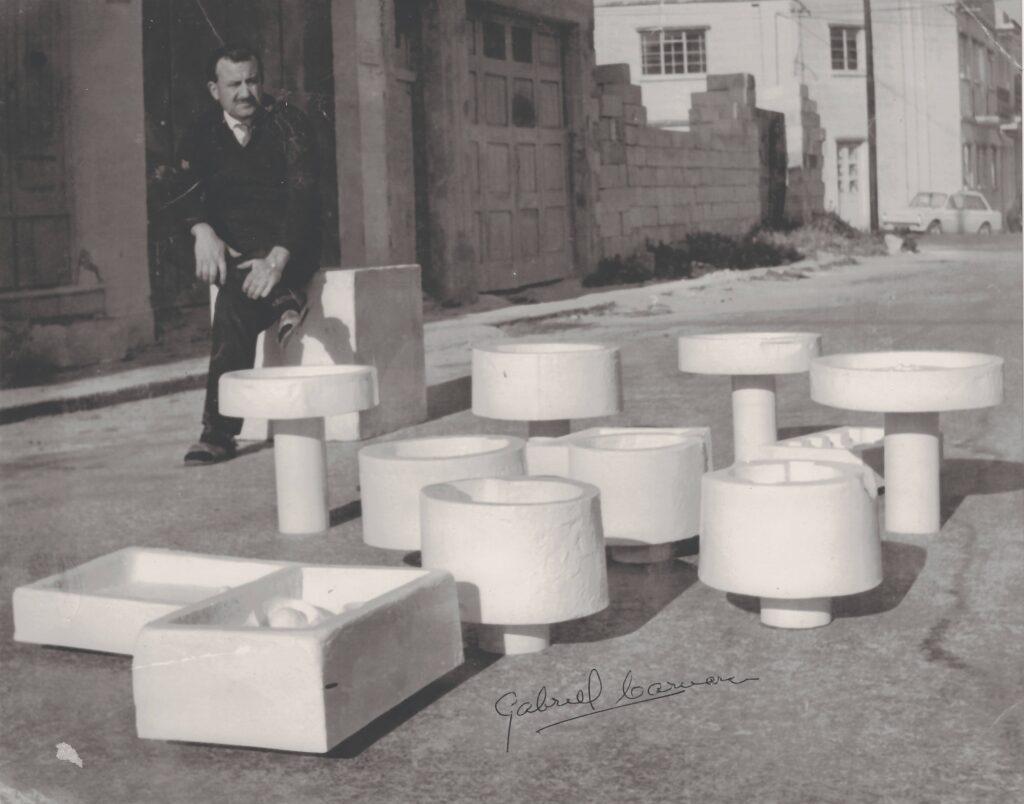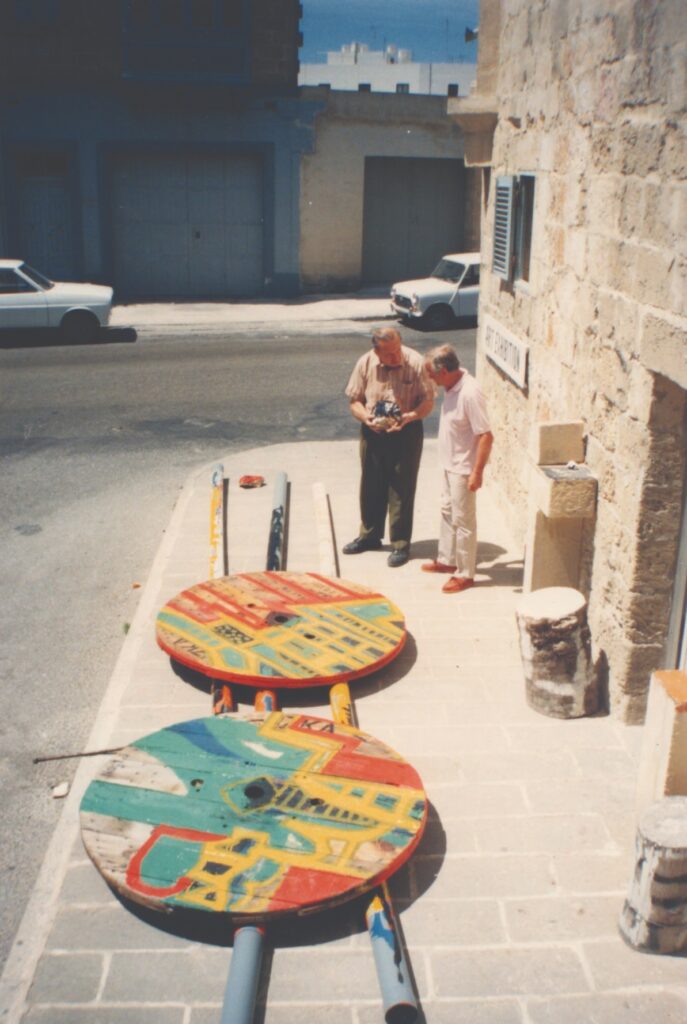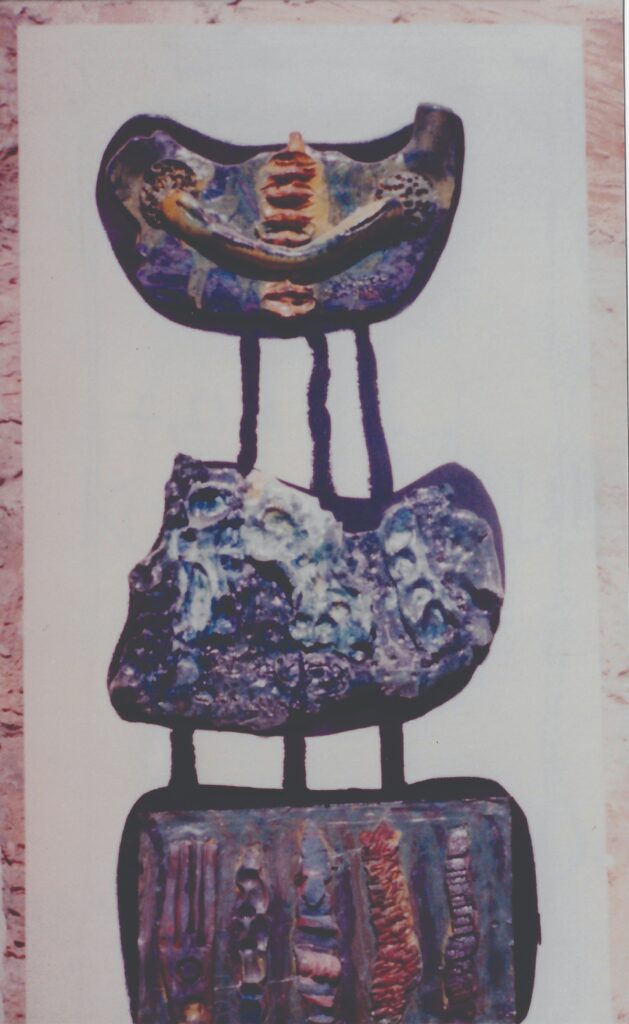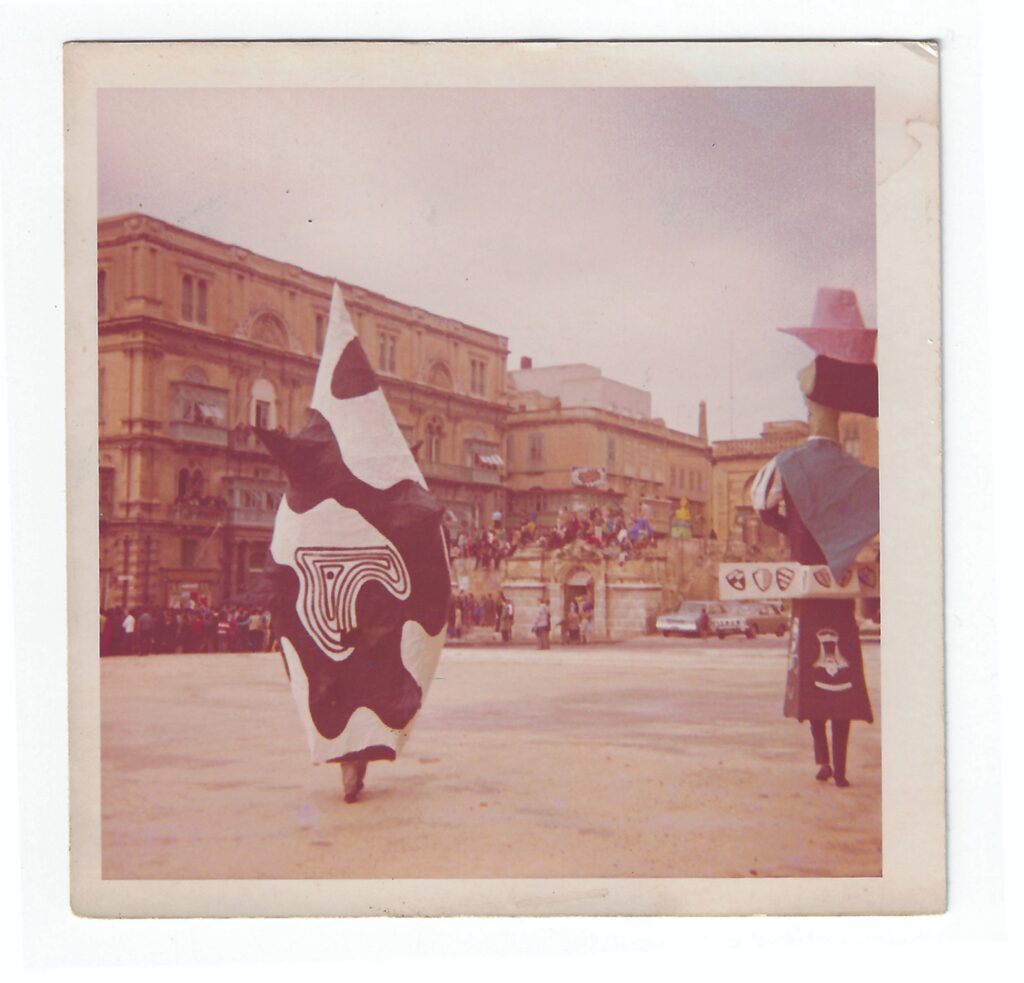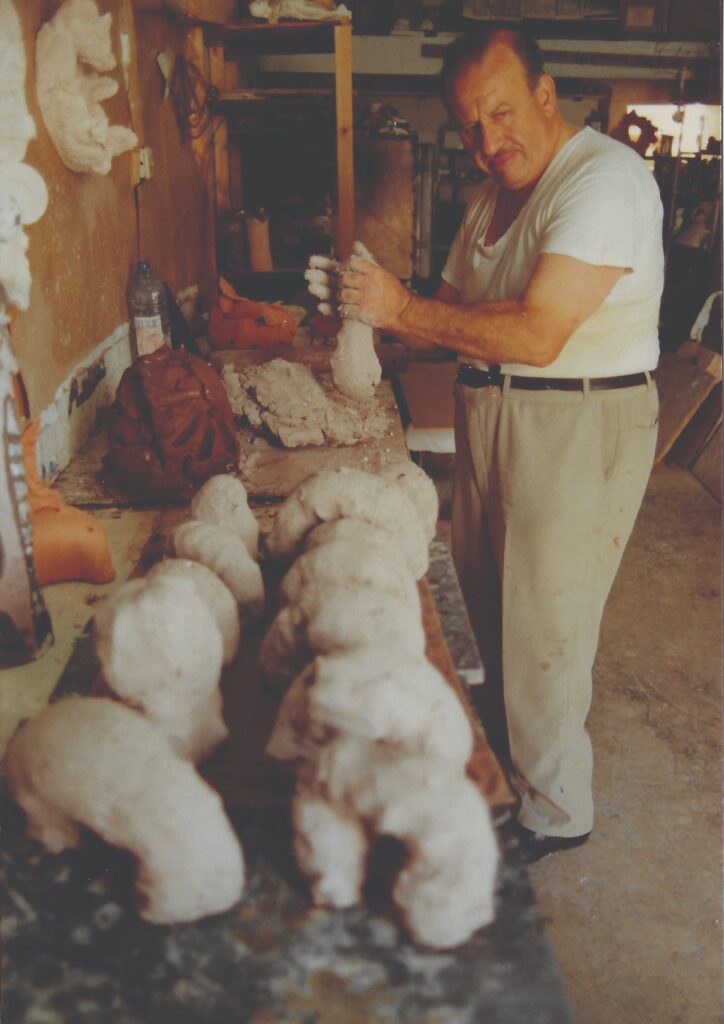Rebellious, non-conforming and spontaneous, Gabriel Caruana left his mark as one of the most influential artists of the 20th century, with his work leaving an impact not only in Malta, but in every other country he travelled to. His brightly-coloured palette, primitive shapes and raw forms are all reminiscent of Malta’s essence – the vivid festa pavilions, crude shorelines and vertiginous carnival floats can all be seen in his art. Malta’s scenery, colours and aesthetics greatly inspired Gabriel’s art – from the primitive spiral drawings found in Neolithic Temples to arid landscapes and flashy Baroque designs commissioned by the Knights – his love for Maltese art reverberated through his creative actions.
The Formative Years
Caruana was born under British colonial rule on the 7th of April 1929 in Balzan, and is considered one of Malta’s best artistic envoys, a pioneer in local art education, a mentor to young artists and a friend to those he crossed paths with.
Son of Malta Police Force Sergeant Anthony Caruana and Beatrice Caruana (née Ebejer), Gabriel came from an artistic family. His grandfather, Master Mason Pio Ebejer, is known for his work at the Bon Pastur Church in Balzan. His uncle Luigi Ebejer created effigies and decorations for religious celebrations, and his grandmother Carmela Ebejer (née Michelizi) was an accomplished pianist.
Gabriel’s mother passed away in 1940 while carrying her sixth child, and being just eleven years old, he was taken in by his grandmother Carmela, an Italian woman who proved to be a behemoth influence in his life and art. Carmela inspired Gabriel in many ways during his formative years. She was a highly cultured musician who grew up in an artistic household and her father was an opera impresario who made a living importing Italian productions to Malta.
It was also during this year that the Second World War erupted, forcing Caruana to refrain from attending school. At the tender age of 11, he took up employment at a Call Office and enrolled in an evening course to obtain an electrician’s warrant.
Political Unrest
Maltese citizens had been split into two factions since the 1930s – one advocating Malta’s unification with Italy and another that opposed it, however it was during the 1940s that this culminated into disastrous results. In 1942 the colonial authorities interned and deported 49 Italophiles, including the leader of the Nationalist Party Enrico Mizzi, to internment camps in Uganda. An additional 700 Maltese people linked to Italian irredentism were sent to concentration camps in Central Africa. This must have made it an arduous time for those of Italian ancestry, like Gabriel’s grandmother.
With such turmoil wrecking havoc on the nation, many Maltese artists were faced with a meandering search for identity. While they didn’t hail from Caruana’s generation, many of these artists had a direct influence over him and his peers as mentors and teachers at the Malta Government School of Arts.
In 1943, Gabriel became an apprentice at a local marsh power plant and the Allies launched the invasion of Sicily. This was machinated and enacted from the Lascaris War Rooms in Valletta and led directly to the fall of Benito Mussolini – resulting in the surrender of Italy to Allied forces.
Grassroots and Folk Creations
Caruana obtained his electrician’s warrant and became a paying member of the Circolo San Gabriele in Balzan in 1945. Ever active within Balzan’s parish celebrations, Caruana was appointed to exercise his creative prowess and electrical craftsmanship in 1950 to map out the exterior lighting of the Parish Church during the feast of the Annunciation. A kaleidoscope of over 1,200 coloured festoons gloriously lit up the church facade that year, a project so popular that Gabriel was commissioned to carry out similar work elsewhere seven years later.
By 1952, Caruana founded the St Gabriel Band Club in Balzan and designed his first-ever Carnival float, ‘Fish & Ties’, which won him first prize during the annual Carnival competition. Gabriel Caruana kept designing and creating carnival floats for years thereafter, fuelling his love for Maltese folk art.
In 1953 Caruana enrolled at the Malta Government School of Art, which at the time was under the direction of Vincent Apap. He was tutored by Emvin Cremona and guided by George Borg. A year later, Caruana established his first studio in Sisters Street, Balzan. Within a year he was commissioned to install St John’s Co-Cathedral’s interior lights – a task which no doubt gave him the chance to get close to the decadent works of art within – further fuelling his inspiration. In the meantime, Gabriel kept himself active by participating in numerous exhibitions, designing carnival floats and furthering his studies at the Malta Government School of Arts.
After his success in decorating the Balzan Parish Church, Caruana was commissioned to design the Floriana Parade Grounds lighting system and create ornamental decorations for Palace Square in Valletta. He was also accepted as a member of the Malta Society of Arts, Manufactures and Commerce. In 1960, he was hand-picked to create the lighting for Emvin Cremona’s compositions for the XIX Centenary of St Paul’s Shipwreck. That same year, Malta saw an influx of artist visitors who would both directly and indirectly influence local artists – Desmond Morris, Nicholas Montserrat, Quentin Hughes and Ernie Bradford.
A Search for Identity
The steady waves of change hit Malta’s shores with a momentum, when in 1964 the county gained independence from its British colonisers. Some argue that this brought with it a rebirth of sorts in the local art scene, as it triggered a search for a true Maltese identity not nabbed from colonisers and past rulers. It was around this time that Caruana started transitioning further into ceramics and hand-modelling – he emulating cart rut lines in his clay tablets and mimicking parched terraced fields in his patterned work. He even drew inspiration from the red ochre spirals and spots rendered on the Hypogeum’s subterranean walls. Caruana’s textures now emulated the water-parched soil, becoming almost primordial, embodying the essence of Malta’s natural landscape and prehistoric imagery.
In 1965, Caruana attended a course at the Academia di Belle Arti Pietro Vannucci, Perugia, where he befriended Italian Futurist painter Gerardo Dottori and Detroit-based Henry Caroselli. Gabriel is later elected to the board of the Malta Society of Arts, where he urges the society to take on additional responsibility at the Venice Biennale. The following year, Caruana travelled to Detroit on Caroselli’s insistence, where he was offered work at the Cranbrook Academy of Art by Professor Julius Schmidt.
Friendships, Studies and Travels
1966 saw the arrival of Victor Pasmore and his family in Malta, foreshadowing the start of a deep-rooted and intimate friendship between him and Caruana. The two offered each other support and encouragement – with Caruana even creating reliefs for Pasmore’s Gudja farmhouse yard walls. The two very quickly became staunch friends, oftentimes creating, exchanging ideas and philosophising with one another. This instilled a profound fondness and admiration of one another, and the two artists regularly spent weekends together when possible.
Caruana enrolled in the Istituto Statale per la Ceramica in Faenza in 1967, and was awarded a bursary by the Italian Government, and special leave with pay from the Department of Education in Malta to further his studies. There he met fellow artists Domenico Matteucci, Panos Tsalakos and Carlo Pauli, and was later awarded a diploma of honour at the sixth Concorso di Ceramice d’Arte in Comune di Cervia.
Another important year in Caruana’s life was 1969, when he held his first two solo exhibitions, one at the Museum of Fine Arts in Valletta, and another at the Mazaron Gallery in St Julian’s, it was also during this year that he developed the Foundation Course at the Targa Gap institute in Mosta. By 1971, Gabriel’s career at Targa Gap Institute took a shift as he now taught ceramics. It was during this time that he met scholar, art historian and writer Charles Sewter, who aided Gabriel in setting up an exhibition at Whitworth Art Gallery in Manchester in 1971.
The work exhibited at Whitworth showed a new face to Caruana’s work, one that seemed to have made peace with the identity question posed to him and his contemporaries almost seven years prior. Neolithic archetypes and prehistoric visages now whirled on Caruana’s clay, ignited by firework-inspired hues and erratic child-like movements.
Between 1971 and 1974, Caruana travelled to the United States, Italy and the United Kingdom where he studied, met other artists and took part in collective exhibitions. He was eventually elected president of the St Gabriel Band Club of Balzan, a position which he held for 16 years. 1975 saw the organisation of the Edinburgh Arts pilgrimage ‘To Callanish from Hagar Qim’, where Gabriel struck a life-long friendship with Scottish-Maltese sculptor Manuel Chetcuti and anti-artist Joseph Beuys, whose Dadaist approach no doubt had an impact on Gabriel’s work. In later years Caruana, ever a pioneer of modern art in Malta, included in his creative focus objets trouvés. A year later, he is awarded a Diploma Magistero di Ceramica from the Centro Leonardo De Medici in Florence.
Approachable Art
In 1980, Gabriel married practicing artist Mary Rose Buttigieg, who studied at the School of Arts in Perugia and taught English and Arts at a local school. Mary Rose was the greatest influence in his life, both personally and artistically – his advisor, critic and even archivist in a sense, as she had been documenting his artistic activity since 1979. The two become parents in 1981, with the birth of their daughter Gabriella, followed by their second child Raffaella in 1983. In 1985, Gabriel Caruana is included in Adrian Stivala’s book Contemporary Maltese Artists.
Caruana retired from his post as ceramics tutor at the Targa Gap institute in Mosta in 1990, and along with his wife Mary Rose, purchased an 18th century mill built by Grandmaster Vilhena. It was then that they made their vision of making art accessible to the public a reality, and founded The Mill, an artist-run art centre that welcomed everyone from friends to family and perfect strangers. The Mill holds a permanent exhibition of Gabriel’s work paired with that of visiting artists. Numerous events are hosted there including literature nights, book launches, talks, exhibitions and workshops. Caruana even dedicated one of the rooms in The Mill to his dear friend and mentor Victor Pasmore.
Between 2001 and 2015, numerous publications featuring Caruana are published, including ‘Gabriel Caruana Ceramics’ by Libria, a book catalogue for the Bank of Valletta exhibition, Bonne Ten Kate’s ‘Another Side of Gabriel – His Non-Ceramic Work’, ‘Conversations with 12 Maltese Artists’, ‘Pioneers of Modern Art in Malta vol.1’ by Joseph Paul Cassar and ‘Gabriel Caruana’ by Kite Group. A ceramic sculpture by Caruana was included in a newly-inaugurated Sculpture Garden at Verdala Palace in 2014. In 2017 Caruana was bestowed with the title of Master of Letters – Honoris Cause by the University of Malta, he also took part in his last collective exhibition at Spazju Kreattiv titled White Memory. He passed away a year later, on the 16th of July 2018 at the age of 89, surrounded by his beloved family at Mater Dei Hospital.
Caruana’s work lives on in both public and private collections around the world – his art touched many and was exhibited in Germany, Japan, Holland, Italy, Malta, Israel, England, Switzerland, Libya, Australia and the United States. Public installations of his can be admired across Austria, Malta and Italy, reflecting his desire for contemporary art to be accessible to the public. His prolific and truly remarkable career spanned for six decades, throughout which he was rightfully awarded countless accolades, including the Medal for Artistic Achievement in 1999 and the Premju Għarfien Kulturali in 2003. In 2014, the Malta Society for Arts awarded Caruana a gold medal in recognition of his contribution as an artist and art educator.
